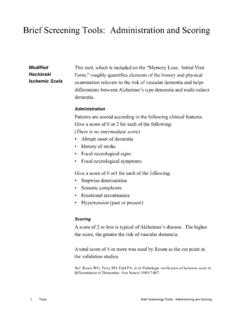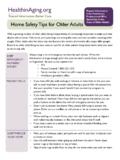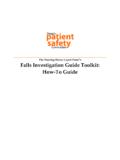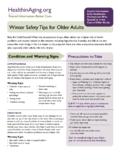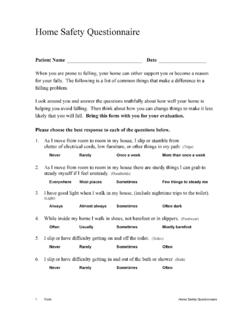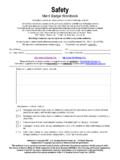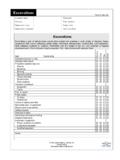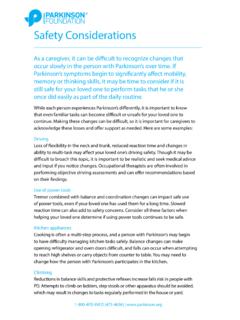Transcription of Falls and Home Safety - gericareonline.net
1 Falls and home Safety Anyone can fall , but the risk for Falls increases as we age. Even Falls that do not lead to injury can affect you. But some simple precautions and a little preparation can help prevent Falls . Who Is at Risk of Falling? More than one-third of people over the age of 65 have at least one fall each year. Sight, hearing, muscle strength, and coordination may not be what they once were. Balance can be affected by diabetes and heart disease, or by problems with your circulation, thyroid, or nervous system. Other common medical conditions that increase your risk of falling include arthritis, cataracts, or hip surgery. Why Are Falls So Dangerous? Injuries sustained in a fall may range from cuts and bruises to life-threatening trauma.
2 Head injuries and broken bones (fractures) lead the list. Even Falls that do not lead to injury can have a negative effect on older adults. After a fall , older people often limit their activity because they are afraid they will fall again. When you reduce your exercise and movement, your body becomes weaker, which can, in turn, increase the risk of another fall . Then there is osteoporosis a disease that makes bones thin and more likely to break. Osteoporosis is a major reason for broken bones in women past menopause, and also affects older men. With more fragile bones, even a minor fall can cause bones to break. Page 1 Falls and home Safety How Do I Make My home Safer?
3 Most Falls occur in the home . You can make your home safer by following these tips: Make sure that you have good lighting in your home . Use night-lights in your bedroom, hall, and bathroom. Put night-lights and light switches close to your bed. Make sure the stairs are well lit, with light switches at the top and bottom of the stairs. Rugs and carpets should be firmly fastened to the floor or have nonskid backing. Loose ends should be tacked down. Keep areas where you walk tidy. Move electrical cords and telephone wires so they are not lying on the floor in walking areas. Put handrails in your bathroom for the bath, shower, and toilet. Do not let your home get too cold or too hot it can make you dizzy.
4 In the kitchen, make sure items are within easy reach. Do not store things too high or too low. Then you will not have to use a stepladder or a stool to stand on. Keep a telephone near your bed. In the living room, keep a telephone next to your favorite chair. What Else Can I Do? Here are some other actions you can take to avoid Falls : Exercise! Get help if you can t find a physical activity that you can do safely. Therapists can get you started. See your doctor if you have dizzy spells or if you fall . See your eye doctor once a year. Have your hearing tested once a year, too. Page 2 Falls and home Safety What Else Can I Do? continued Take good care of your feet and have them examined if you have pain or difficulty walking.
5 If your doctor suggests that you use a cane or a walker to help you walk, please use it! This will give you extra stability when walking and may help you avoid a bad fall . Do not use stairs without rails on both sides for support. If you must carry something while you are going up or down, hold it in one hand and use the handrail with the other. Do not take chances! Stay away from a freshly washed floor. Never stand on a chair or table to reach something that is too high. Wear shoes with firm non-skid, non-friction soles. Avoid wearing loose-fitting slippers that could cause you to trip. When you get out of bed in the morning or at night to use the bathroom, sit on the side of the bed for a few minutes before standing up.
6 Moving too quickly can make you dizzy, and you might lose your balance and fall . Resources Organizations Consumer Product Safety CommissionWashington, DC 20207 Phone: (800) 638-2772 TTY: (800) 638-8270 Web site: For information on simple, inexpensive repairs and changes to make you home safer, ask for a free copy of the booklet home Safety Checklist for Older Consumers. Page 3 Falls and home Safety Page 4 Resources, continued Organizations, continued National Center for Injury Prevention and Control Centers for Disease Control and Prevention Mailstop K65 4770 Buford Highway NE Atlanta, GA 30341-3724 Phone: (800) 311-3435 Web site: Institute on Aging Information Center Box 8057 Gaithersburg, MD 20898-8057 Phone: (800) 222-2225 TTY: (800) 222-4225 E-mail: order publications online: Web Sites This site of the American Physical Therapy Association, Geriatrics section provides information and useful links for physical therapy clinicians and consumers.
7 The consumer section of this site contains a search feature to locate a certified geriatric Physical Therapist Specialist in your area. Up-to-date, quality health care information. Go to Health Topics, Falls . Information on preventing Falls and fractures.

